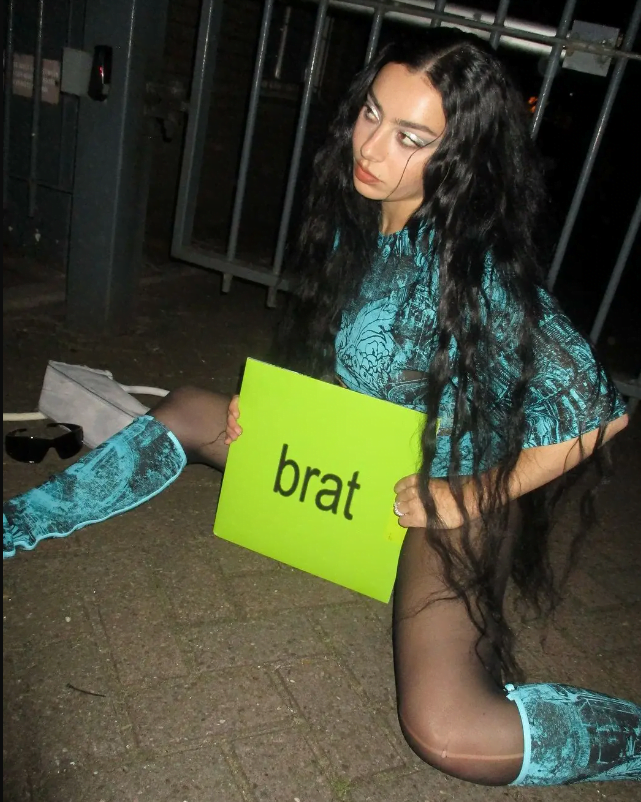Brat summer has surged across social media, adding to the extensive roster of music marketing trends that emerge and dissipate with striking rapidity. As we witness the death of yet another wildly successful phenomenon, it becomes important to analyse the very real sociopolitical implications of these seemingly inescapable, yet invariably ephemeral trends in global pop culture.
What is Brat and why does it matter?
English singer-songwriter Charli XCX’s sixth studio album Brat has taken the internet by storm. Reigning at No. 2 in the UK album chart and No. 3 in the US Billboard chart, it is impossible to have evaded the cover’s pervasive slime green, with ‘brat‘ written in a low-resolution Aerial font. The spirit of the album transcends its functionality, becoming more than just a collection of songs.
Fundamentally, a Brat is a girl. It is a largely self-defining category, featuring wild hair and unapologetically strong opinions. She wears stringy tanks without bras, and empty Marlboro packets litter her room. She is messy, hedonistic, and unashamedly annoying, completely rejecting the social confinement of young girls into neat, acceptable categories.

You cannot buy brat off a rack. The DIY ethos is central to her identity. Brat is a product of self-creation, pieced together from whatever feels right in the moment. “The album is really confessional but also really brash – it feels like voice notes to your friends,” Sheena Patel, a novelist, tells The Guardian, “Charli xcx feels like a Dionysian agent for being more unhinged.” An off-shoot of hot-girl summer and rat-girl summer, brat summer is about embracing individuality.
An off-shoot of hot-girl summer and rat-girl summer, brat summer is about embracing individuality.
Monica Heisey, the Canadian author of Really Good, explains in The Guardian “[the album is about] feminine contradiction – the way someone can be a 365 party girl and also anxious about motherhood, the way friendship with other powerful women can be both empowering and a source of anxiety, the way a full-on thirty something woman can still feel like a girl inside. It’s also about saying: fuck those contradictions, I’m having fun and I don’t care if I’m being a little annoying about it.”
Brat functions in direct opposition to the clean girl ideal that has been popularised by influencers on Instagram and X (Twitter). The clean girl, aesthetic is characterised by a slicked-back bun, neutral feminine clothes, minimalistic jewellery and natural makeup. In stark contrast, Brat embraces chunky shades, open hair, gloss-dipped lips, faux leather and smoky eyes. In an interview with The News Movement, Charli XCX claimed “It can be like, so trashy. Just like a pack of cigs and a Bic lighter. And like, a strappy white top with no bra. That’s like, kind of all you need.”
Brat now stands as a paradox of countercultural movements within a capitalist society, where rebellion itself can be commodified and used to reinforce the systems it originally opposed.
Additionally, it is a backlash against the overconsumption promoted by the clean girls of TikTok. It is brat to repeat clothes, reuse washed-out tees and wear the same pair of boots all year round. The pulse of Brat is about not confining to a feminine ideal (think Fleabag, Madonna and Chappell Roan). Instead, it centres on the female gaze and reclaiming agency, celebrating a form of self-expression that challenges traditional gender norms and asserts economic autonomy.
However, by sowing the seeds of this summer’s greatest music promotion, Charli has simultaneously broken the internet and spurred new marketing strategies and revitalisation of brands. Linkedin is now splattered with brat green, as brand strategists from fin-tech startups to B2Bs co-opt the subversive artistic expression into the very capitalist frameworks it might have sought to critique. Brat now stands as a paradox of countercultural movements within a capitalist society, where rebellion itself can be commodified and used to reinforce the systems it originally opposed.
The impact of popular culture in governance
Popular culture has long stood as an influential agent in analysing responses and unrest to legislative decisions. Additionally, creative spaces function as sites of revolution and counter-response to authority. These comprise a full range of reactions to domination, including negotiation, protest, and even periods of neutrality or accommodation. It is, therefore, conversely true that popular culture leveraged by politicians serves as a means to appeal to the masses.
Celebrities who cross over into politics, such as Ronald Reagan and Donald Trump, have harnessed their public personas to gain political power. This interdependence between film, the music industry, and politics demonstrates the power of popular culture as both a tool for political messaging and a platform for aspirational leadership. Running parallel is the figure of the political celebrity, who not only uses their fame to influence public opinion but also effectively symbolises a merging of entertainment and governance, blurring the boundaries between performance and politics.

The recent sweeping success of Brat in international space, and its percolation into the American presidential campaign, signal a third layer in this evolving dynamic. Brat, originally a cultural phenomenon, has become emblematic of how entertainment can shape political discourse. It spotlights the increasing role of social media and digital platforms in creating and amplifying the journey of a cultural icon to a relatable campaign tool.
Kamala Harris’ campaign, as the new Democratic candidate against Donald Trump in the 2024 US presidential race, has been actively working to appeal to Gen-Z voters. Among her various campaign strategies, the Brat phenomenon has formed a crucial pillar, especially after Charli XCX’s endorsement with the statement “Kamala IS Brat” on X. Since then, Kamala’s header on X has changed to brat green, reading “kamala hq” in unmistakable Aerial. Edits on TikTok and Instagram show Kamala Harris in songs from the album.
Other politicians like Tim Kaine and the Democratic Lieutenant Governors Association raised the question “Did someone say demo(b)rat” on X. Furthermore, Mayor of London Sadiq Khan recently praised the success of the Ultra Low Emission Zone expansion in a post-styled after the font and aesthetic of the Brat album.
The rise of the Brat trend and its integration into Kamala Harris’s campaign reflects a strategic pivot in political image-making, contrasting sharply with Donald Trump’s embodiment of the macho man archetype. By adopting the Brat aesthetic and embracing the moniker “Momala,” Harris navigates a cultural landscape rich in identity politics and visual symbolism. This shift raises critical questions about the extent to which such cultural phenomena influence political narratives. As the Brat meme becomes a central element of Harris’s X profile, it invites scrutiny over the boundaries between public engagement and substantive political dialogue. This phenomenon prompts a deeper inquiry into whether the emphasis on identity politics and cultural branding might overshadow pressing policy issues, challenging us to consider when the pursuit of a compelling image might detract from addressing the core concerns of the electorate.
About the author(s)
Gayathri S (she/her) is currently pursuing her master's in English. With a deep-rooted love for literature and writing, she hopes to streamline her interests towards a career in journalism. Alongside her studies, Gayathri has gained practical experience through internships in content writing, editing, and research. These opportunities have strengthened her commitment to impactful storytelling and managing projects aligned with broader social goals. Gayathri looks forward to merging her passion for writing with journalism, where she can explore and report on diverse narratives.






